Regular script "The Epitaph of Yan Ren (严仁墓志)", written by Zhang Xu in Tang Dynasty. Yan Ren's epitaph was discovered in January 1992 at a Tang tomb excavated at the expansion and reconstruction site of Yanshi County Phosphate Fertilizer Plant at the foot of Manshan Mountain, Luoyang City, Henan Province. Zhiwen regular script, a total of 21 lines, a full line of 21 characters, a total of 430 characters. This monument is only one year apart from the writing time of "Lang Guan Shi Zhu Ji", although it is not as strong as "Lang Guan Shi Zhu Ji", but the shape of the characters is square and the breath is similar, and it should be written by Zhang Xu. "A Record of Famous Paintings in Past Dynasties" by Zhang Yanyuan of the Tang Dynasty stated: "Just as Zhang Dian got its name from good grass, Kaili may not be treasured by others. I have seen "Le Yi" in small letters, Yu and Chu." It can be seen that people in the Tang Dynasty. For Zhang Xu's calligraphy, he only pays attention to his cursive script.

"The Epitaph of Yan Ren (严仁墓志)" is consistent in the spirit and spirit of the whole text, and the whole text is integrated, and the whole seems to have a kind of joyful strokes. Although there are bounding grids inscribed on the stone of the Epitaph of Yan Ren, the size of the characters written in the grids are different. Shudan basically guards the bounding grids, and the pen is vigorous, and you can see the feeling of the strokes of each dot and stroke when writing. The dots and strokes of the characters, some are full, some are thin and hard, and are not uniform. The changes in the structure of the glyphs are obvious, and some of the glyphs even have a sense of instability. The calligraphy of "The Epitaph of Yan Ren (严仁墓志)" is straightforward, and there is a kind of unruly attitude between the dots and strokes, which is in line with Zhang Xu's personality. The characters written on the epitaph have a state of writing and disdaining more arranging, so I saw the whole calligraphy handwriting perfectly, and there was no cowardly twitching state of imitations. The epitaph of Yan Ren’s epitaph was originally titled "The epitaph of the Emperor Weiyan Mansion in Longmen County, Jiangzhou, Jiangzhou, Tang Dynasty", with a square border on the stone. Zhiming later deployed "Former Dengchuan Neixiang County magistrate Wu Jun Zhang Wanqing wrote Wu Jun Zhang Xushu".

Not all the characters written by the famous great calligraphers in history will be satisfactory, and no one can guarantee that the characters written by Zhang Xu of the Tang Dynasty will not have flaws or typos. "The Epitaph of Yan Ren" is entirely possible because Zhang Xu, the alchemist, was too lazy to move his position many times, and the epitaph stone is a heavy object that is not easy to move, so I wrote it all the way and then over, and quickly wrote the entire inscription, so The problem of imbalance of the glyph structure of the special parts on the Zhishi appeared. The calligraphy of "The Epitaph of Yan Ren" has two obvious features, that is, there are typos and simplified characters. These two points are also found in the handed down calligraphy "Langguan Shiji Preface". If you focus on the typos, it may provide information from another aspect for identifying Zhang Xu's regular script. Considering Zhang Xu's frank writing, writing more or less strokes on the dots and strokes of the characters has become an alternative style of Zhang Xu's regular script. Because some of the characters in the "Embrace of Yan Ren" are not perfect, an article pointed out: "On the whole, "The Epitaph of Yan Ren" has a typical Tang calligraphy. According to specific analysis, many characters are actually inscribed. Be precise, not far from the style and appearance of "Lang Guan Shi Zhu Ji"."
Luoyang was the place where Zhang Xu went to activities several times in his life. Luoyang area was also the focus of the activities of officials and literati in Tang Dynasty. Zhang Xuying was invited by "Wu Jun Zhang Wanqing" to be the epitaph of "Yuhang County" Yan Ren. One was because of his familiarity with the writer, and the other was from the writer, the man and the owner of the tomb. The relationship between Wu Yue and his fellow villagers. Because of the relationship between human sentiment and the prefecture, Zhang Xu's writing of "The Epitaph of Yan Ren" is completely natural and logical. As a funerary object, epitaphs were popular in the Tang Dynasty. The writers of epitaph texts and calligraphers were generally people who had a relationship with the tomb owner during his lifetime, or were the attention of the family of the tomb owner.








